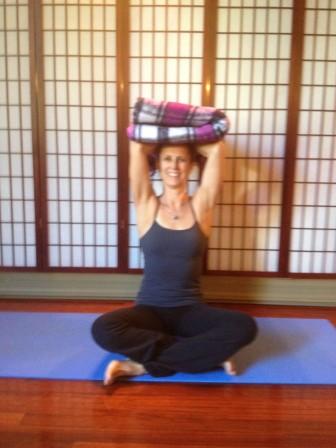Yoga is a balance of strength and flexibility. We need to be strong but not rigid. Being strong gives us a firm foundation and clear boundaries. Being rigid keeps us stuck, frozen in one place. In being flexible, we need to be resilient, able to change and go with the flow, but not so flexible that we can be pushed over. This is as true in our yoga postures as it is in life.
We will begin this year by developing our strength by working our core in the various forms of Plank Pose. Our core connects our upper body and lower body together, protecting our spine and integrating our postures. Think of Plank Pose as Tadasana in alternate relationships to gravity using different arm positions. Tadasana is the first version of Plank. Use this posture to check your alignment for each of the other versions. Each version of Plank should still look like Tadasana.
There is Plank pose with the arms held straight out in front of the body. You can do Plank pose on your hands or on your forearms. The forearm version is not just for people who have wrist issues. When practicing Forearm Plank, make sure that you keep your forearms parallel. In either version of Plank, make sure your hips are in line with your body, not high like a tent and not low like a hammock. There is also a moving version of Plank called “walking plank”. This is where you transition back and forth from Plank on your hands to Plank on your forearms, one arm at a time.
Caturanga Dandasana, or Low Plank is a harder version of Plank and relies more on upper body strength than just core. Make sure that your elbows are stacked over your wrists and your shoulders are kept in line with your elbows as you hold this pose.
The next version of Plank Pose is with the arms straight out from the shoulders in the side plane. This is Side Plank or Vasisthasana. It works your oblique muscles, or the abdominal muscles that wrap around the side of your body. Even though the body is tipped over sideways, it should still look like you are holding Tadasana. Don’t sag or arch!
You may have never thought of Handstand as a version of Plank, but it is Plank with the arms overhead. Again the body should look the same way it does in Tadasana. It should not look like a banana. If the ribs flare out you have lost your core. Of course, there is a Scorpion version of Handstand that is more difficult.
Reverse Plank is the last version, with the arms in the back plane of the body. This works the muscles in the back plane of the body including your hamstrings and glutes. People often think of core as just abs, but the posterior chain muscles are just as important to keeping our spine stabilized, supported and our posture well integrated.
Working our core in these versions of Plank Pose will set us up for a great beginning to a New Year!
I’ll see you in class!
Karin












